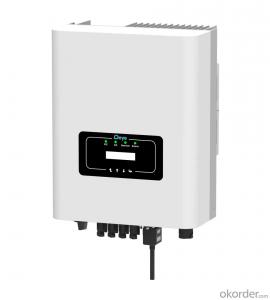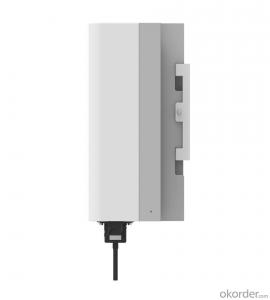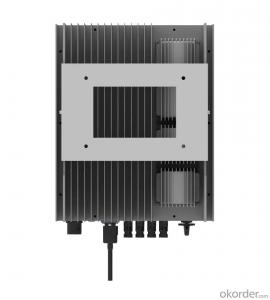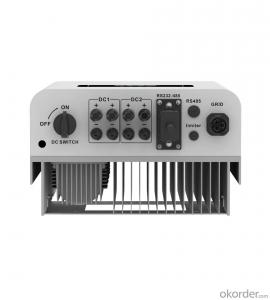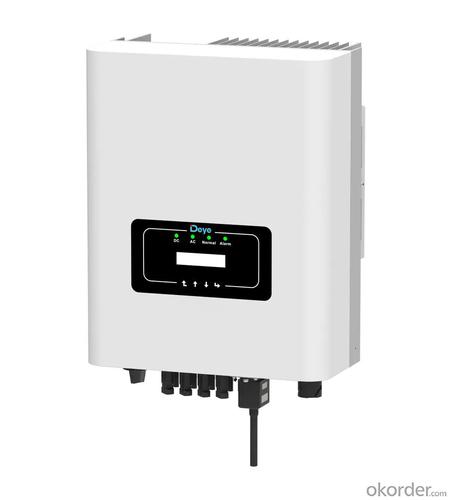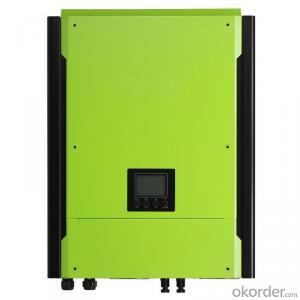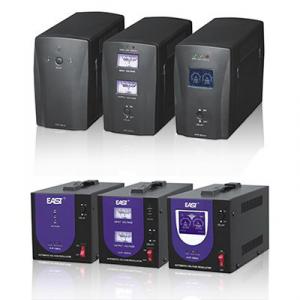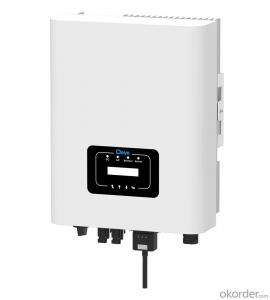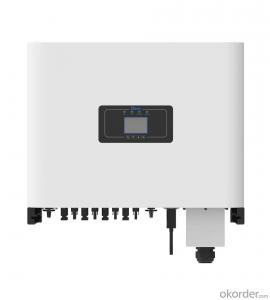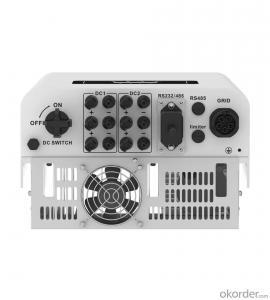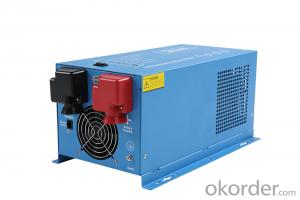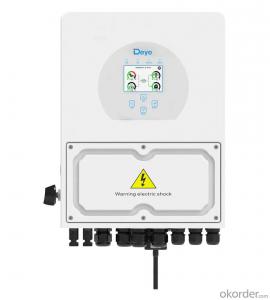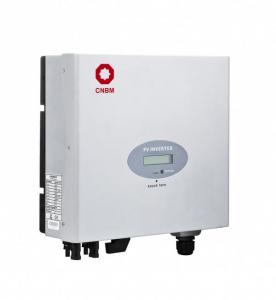200KW Solar Inverter - Sun-7/7.5/8/9/10/10.5k-g | 7-10.5kW | Single Phase | 2 MPPT
- Loading Port:
- Ningbo
- Payment Terms:
- TT OR LC
- Min Order Qty:
- 100 pc
- Supply Capability:
- 5000 pc/month
OKorder Service Pledge
OKorder Financial Service
You Might Also Like
Specification
| Model | SUN-7K-G | SUN-7.5K-G | SUN-8K-G | SUN-9K-G | SUN-10K-G | SUN-10.5K-G | |
| Input Side | |||||||
| Max. DC Input Power (kW) | 9.1 | 9.8 | 10.4 | 11.7 | 13 | 13.7 | |
| Max. DC Input Voltage (V) | 550 | ||||||
| Start-up DC Input Voltage (V) | 80 | ||||||
| MPPT Operating Range (V) | 70~500 | ||||||
| Max. DC Input Current (A) | 13+26 | 26+26 | |||||
| Max. Short Circuit Current (A) | 19.5+39 | 39+39 | |||||
| Number of MPPT / Strings per MPPT | 2/1+2 | 2/2 | |||||
| Output Side | |||||||
| Rated Output Power (kW) | 7 | 7.5 | 8 | 9 | 10 | 10.5 | |
| Max. Active Power (kW) | 7.7 | 8.25 | 8.8 | 9.9 | 11 | 11.55 | |
| Nominal Output Voltage / Range (V) | L/N/PE 220V/0.85Un-1.1Un, 230V/0.85Un-1.1Un (Optional) | ||||||
| Rated Grid Frequency (Hz) | 50 / 60 (Optional) | ||||||
| Operating Phase | Single phase | ||||||
| Rated AC Grid Output Current (A) | 30.4 | 32.6 | 34.8 | 39.1 | 43.5 | 45.7 | |
| Max. AC Output Current (A) | 33.5 | 35.9 | 38.3 | 43 | 47.8 | 50.2 | |
| Output Power Factor | 0.8 leading to 0.8 lagging | ||||||
| Grid Current THD | <3% | ||||||
| DC Injection Current (mA) | <0.5% | ||||||
| Grid Frequency Range | 47~52 or 57~62 (Optional) | ||||||
| Efficiency | |||||||
| Max. Efficiency | 97.7% | ||||||
| Euro Efficiency | 97.5% | ||||||
| MPPT Efficiency | >99% | ||||||
| Protection | |||||||
| DC Reverse-Polarity Protection | Yes | ||||||
| AC Short Circuit Protection | Yes | ||||||
| AC Output Overcurrent Protection | Yes | ||||||
| Output Overvoltage Protection | Yes | ||||||
| Insulation Resistance Protection | Yes | ||||||
| Ground Fault Monitoring | Yes | ||||||
| Anti-islanding Protection | Yes | ||||||
| Temperature Protection | Yes | ||||||
| Integrated DC Switch | Yes | ||||||
| Remote software upload | Yes | ||||||
| Remote change of operating parameters | Yes | ||||||
| Surge protection | DC Type II / AC Type II | ||||||
| General Data | |||||||
| Size (mm) | 330W×410H×198.5D | ||||||
| Weight (kg) | 15.7 | ||||||
| Topology | Transformerless | ||||||
| Internal Consumption | <1W (Night) | ||||||
| Running Temperature | -25~65℃, >45℃ derating | ||||||
| Ingress Protection | IP65 | ||||||
| Noise Emission (Typical) | <25 dB | ||||||
| Cooling Concept | Natural cooling | ||||||
| Max. Operating Altitude Without Derating | 2000m | ||||||
| Warranty | 5 years | ||||||
| Grid Connection Standard | CEI 0-21, VDE-AR-N 4105, NRS 097, IEC 62116, IEC 61727, G99, G98, VDE 0126-1-1, RD 1699, C10-11 | ||||||
| Operating Surroundings Humidity | 0-100% | ||||||
| Safety EMC / Standard | IEC/EN 61000-6-1/2/3/4, IEC/EN 62109-1, IEC/EN 62109-2 | ||||||
| Features | |||||||
| DC Connection | MC-4 mateable | ||||||
| AC Connection | IP65 rated plug | ||||||
| Display | LCD1602 | ||||||
| Interface | RS485/RS232/Wifi/LAN | ||||||
· 2 MPP trackers, Max. efficiency up to 97.7%
· Zero export application, VSG application
· String intelligent monitoring (optional)
· Wide output voltage range
· Anti-PID function (Optional)
The single-phase inverter is one of the best options for residential application thanks to its smaller size and local LCD display, buttons. Also, with built-in zero-export function (external CT is needed), it offers true ease and comfort for PV system operators and installers.
- Q: What is the role of a grid-tie inverter in a solar PV system?
- The role of a grid-tie inverter in a solar PV system is to convert the direct current (DC) electricity generated by the solar panels into alternating current (AC) electricity that can be fed directly into the electrical grid. It synchronizes the electricity produced by the solar panels with the grid's frequency and voltage, allowing the excess energy to be sent back to the grid for use by other consumers.
- Q: How is the efficiency of a solar inverter measured?
- The efficiency of a solar inverter is typically measured by dividing the output power of the inverter by the input power, and then multiplying the result by 100 to get a percentage value.
- Q: What is the maximum number of AC outputs in a solar inverter?
- The maximum number of AC outputs in a solar inverter can vary depending on the specific model and design, but typically it ranges from one to three AC outputs.
- Q: Can a solar inverter be monitored remotely?
- Yes, a solar inverter can be monitored remotely. Many modern solar inverters have built-in monitoring capabilities that allow users to track the performance and energy production of their solar system from a remote location. This can be done through software applications or web-based platforms that provide real-time data and analytics, enabling users to monitor the system's efficiency, diagnose issues, and optimize its performance without physically being present at the location of the inverter.
- Q: How is the output voltage and frequency of a solar inverter regulated?
- The output voltage and frequency of a solar inverter are regulated through a combination of control algorithms and power electronics. These control algorithms constantly monitor and adjust the voltage and frequency based on the energy generated by the solar panels and the power requirements of the connected load. The power electronics, such as voltage regulators and frequency converters, ensure that the output voltage and frequency remain within the desired range. This regulation is crucial to provide stable and consistent power to the electrical grid or the connected devices.
- Q: What is the role of a fault detection feature in a solar inverter?
- The role of a fault detection feature in a solar inverter is to monitor and identify any abnormalities or malfunctions in the system. This feature plays a crucial role in ensuring the reliable and efficient operation of the solar inverter. A fault detection feature is designed to constantly monitor the various components and parameters of the solar inverter, including input voltage, output voltage, current levels, temperature, and other critical parameters. It analyzes the data in real-time and compares it with predefined thresholds or expected values. If any parameter deviates from the normal range or exceeds the set limits, the fault detection feature immediately identifies it as a fault or abnormality. The primary purpose of this feature is to protect the solar inverter from potential damage and prevent any possible safety hazards. By promptly detecting faults, it enables the inverter to take appropriate actions to mitigate the issue or to shut down the system if necessary. This helps in avoiding further damage to the inverter or other connected devices. Additionally, the fault detection feature aids in troubleshooting and diagnosing the root cause of the fault. It provides valuable information about the type and location of the fault, facilitating quicker and more accurate repairs or maintenance. This reduces downtime and ensures the optimal performance and longevity of the solar inverter. Furthermore, the fault detection feature plays a vital role in system monitoring and maintenance. It provides valuable data and alerts to the system operator or maintenance personnel, enabling them to proactively address any potential issues. This helps in maximizing the uptime of the solar inverter and minimizing the overall maintenance costs. In summary, the fault detection feature in a solar inverter is responsible for continuously monitoring, identifying, and responding to any faults or abnormalities in the system. It acts as a protective mechanism, ensuring the safe and reliable operation of the inverter, enabling quick troubleshooting, and facilitating efficient maintenance practices.
- Q: Can a solar inverter be installed indoors or outdoors?
- A solar inverter can be installed both indoors and outdoors, depending on the specific requirements and preferences of the installation. However, it is essential to consider factors such as available space, ventilation, temperature regulation, and protection from environmental elements when deciding on the installation location.
- Q: How does a solar inverter affect the overall energy consumption of a property?
- A solar inverter converts the direct current (DC) generated by solar panels into alternating current (AC) that can be used to power electrical appliances in a property. By efficiently converting DC to AC, a solar inverter enables the property to utilize the renewable energy generated by the solar panels. This reduces the reliance on grid electricity, thereby decreasing the overall energy consumption of the property and leading to potential cost savings on electricity bills.
- Q: What are the main components of a solar inverter system?
- The main components of a solar inverter system include the solar panels, the inverter itself, a charge controller, batteries (if it is an off-grid system), and the electrical wiring and connections.
- Q: What is the role of a solar inverter in a solar-powered desalination system?
- The role of a solar inverter in a solar-powered desalination system is to convert the direct current (DC) electricity generated by the solar panels into alternating current (AC) electricity that can be used to power the desalination process. The inverter ensures that the energy produced by the solar panels is compatible with the desalination system, allowing it to operate efficiently and effectively.
Send your message to us
200KW Solar Inverter - Sun-7/7.5/8/9/10/10.5k-g | 7-10.5kW | Single Phase | 2 MPPT
- Loading Port:
- Ningbo
- Payment Terms:
- TT OR LC
- Min Order Qty:
- 100 pc
- Supply Capability:
- 5000 pc/month
OKorder Service Pledge
OKorder Financial Service
Similar products
Hot products
Hot Searches
Related keywords
